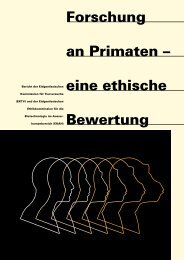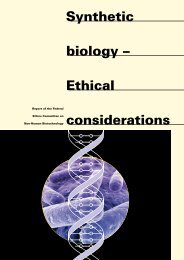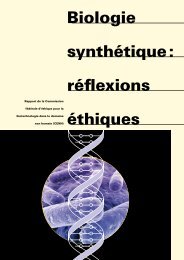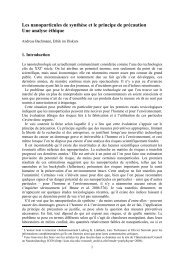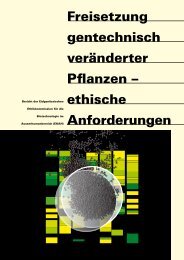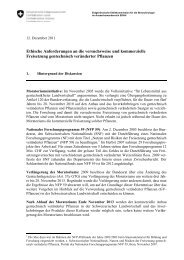Helmut Segner Fish Nociception and pain A biological perspective
Helmut Segner Fish Nociception and pain A ... - EKAH - admin.ch
Helmut Segner Fish Nociception and pain A ... - EKAH - admin.ch
- No tags were found...
You also want an ePaper? Increase the reach of your titles
YUMPU automatically turns print PDFs into web optimized ePapers that Google loves.
archi- <strong>and</strong> palaeo cortex. In humans, the neocortex is involved in<br />
higher functions such as sensory perception (including <strong>pain</strong>), generation<br />
of purposive motor comm<strong>and</strong>s, spatial reasoning, conscious<br />
thought <strong>and</strong> language. The neocortex is folded to accomodate its<br />
increasing volume. The folds are called gyri, <strong>and</strong> the grooves in<br />
between are designated as sulci. The cortex is anatomically subdivided<br />
into frontal, temporal, parietal <strong>and</strong> occipital lobes, <strong>and</strong> it<br />
contains many subregions with distinct functions, e. g., the cingulate<br />
cortex which is located close to the corpus callosum, or the<br />
primary somatosensory cortex in the frontal lobe.<br />
The diencephalon includes (i) the ventral hypothalamus, with a<br />
number of neurosecretory functions <strong>and</strong> intimate relationship to<br />
the hypophysis or pituitary l<strong>and</strong>, (ii) the dorsal epithalamus, with<br />
the pineal gl<strong>and</strong> which secretes melatonin, <strong>and</strong> (iii), the thalamus,<br />
which basically represents the lateral walls of the diencephalons.<br />
The diencephalon also houses the chiasma opticum.<br />
The metencephalon contains as a prominent structure the<br />
cerebellum. This brain part is important for equilibrium, <strong>and</strong> it<br />
processes information pertaining to touch, vision, hearing, proprioreception<br />
<strong>and</strong> motor information from higher centres. The<br />
cerebellum modifies, refines <strong>and</strong> monitors motor activity, but it<br />
does not initiate it. An important pathway of information exchange<br />
between cortex <strong>and</strong> cerebellum is the pons. Often, the midbrain<br />
structures cerebellum <strong>and</strong> pons, together with the medulla, are<br />
designated as brainstem; the brainstem connects the cerebellum<br />
with the spinal cord, <strong>and</strong> it controls autonomic functions of the<br />
peripheral nervous system.<br />
The myelencephalon contains the nuclei of a number of cranial<br />
nerves, <strong>and</strong> the medulla oblongata, which operates primarily at the<br />
reflex level. Information arriving via ascendent projections is partly<br />
processed in the medulla, <strong>and</strong>, vice versa, efferent output to adjust<br />
visceral or reflexive motor activity is initiated here.<br />
A brain component that is frequently mentioned in the context<br />
of <strong>pain</strong> perception is the limbic system. It is not an anatomically<br />
discrete region but represents a functional association between several<br />
cortical <strong>and</strong> subcortical centers. There is no generally accepted<br />
definition which brain structures constitute the limbic system but<br />
most frequently the following structures are included: insular <strong>and</strong><br />
cingulate cortex, thalamus, hypothalamus, hippocampus, amygda-<br />
Figure 3: Schematic of ascending<br />
pathways, subcortical structures,<br />
<strong>and</strong> cerebral cortical structures<br />
involved in <strong>pain</strong> perception.<br />
(Modified from Price, 2000)<br />
PAG periaque ductal gray,<br />
PB parabrachial nucleus of the<br />
dorsolateral pons,<br />
VMpo ventromedial part<br />
of the posterior nuclear complex<br />
of the thalamus,<br />
MDvc ventrocaudal part of the<br />
medial dorsal nucleus of the thalamus,<br />
VPL ventroposterior lateral<br />
nucleus of the thalamus,<br />
ACC anterior cingulate cortex,<br />
PCC posterior cingulate cortex,<br />
HT hypothalamus,<br />
S1 <strong>and</strong> S2 primary <strong>and</strong> secondary<br />
somatosensory cortical areas,<br />
PPC posterior parietal complex,<br />
SMA supplementary motor area,<br />
AMYG amygdala,<br />
PF prefrontal cortex.<br />
22 <strong>Fish</strong>. <strong>Nociception</strong> <strong>and</strong> <strong>pain</strong> | Contributions to Ethics <strong>and</strong> Biotechnology<br />
<strong>Fish</strong>. <strong>Nociception</strong> <strong>and</strong> <strong>pain</strong> | Contributions to Ethics <strong>and</strong> Biotechnology<br />
23



